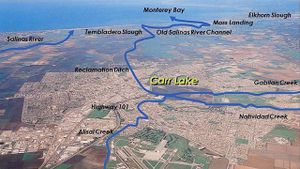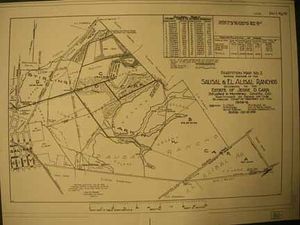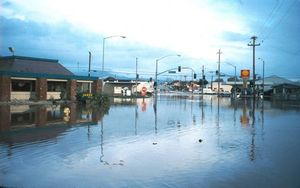Conversion of Carr Lake to a Multi-Use Park
A watershed-related issue examined by the ENVS 560/L Watershed Systems class at CSUMB.
Contents
Summary
Carr Lake, the largest of 7 historical lakes in the lower Salinas Valley, is located in the heart of the City of Salinas. The lake drains approximately 157 square miles of land into Monterey Bay. After the construction of the Reclamation Ditch in 1917, Carr Lake only holds water during large flooding events [1]. Most of the 450 acres of historical lake bed has since been converted to agricultural land.
Currently, there is an effort to purchase this land and convert it to a regional park with recreational areas for the people of Salinas, a wetland area to improve water quality and mitigate flooding during high storm years, and an educational place where people can explore and study nature[2] [3] [4] . In January 2017, the Big Sur Land Trust purchased 73 acres of this historical land site from the Ikeda family for $3.95 million[4]. On February 17, 2018, the first oak tree, California poppy, and other native plant seeds were planted in Carr Lake by the CSUMB program, Return of the Natives. [5]
Location
Carr Lake is located at the confluence of three tributaries: Gabilan Creek, Alisal Creek and Natividad Creek. It drains into the the Gabilan / Reclamation Ditch Watershed which flows to the Pacific Ocean at Moss Landing Harbor. It is located in the center of the City of Salinas and bounded by Laurel Drive, Sherwood Drive, Natividad Road and Highway 101. Most of Carr Lake has been converted to agricultural land[3].
History
Construction on the Reclamation Ditch began in 1917 in order to increase the available acreage needed for productive agricultural lands. The channel extraction deepened the three incoming tributaries allowing them to hold more water, which drained the seasonally present Carr Lake[3]. Jesse D. Carr, the original owner of the drained lands, sold the historical lake site and its surrounding lands off to another family. The land was passed down to their descendants: the Ikedas, the Hibinos, and the Higashis[2].
General Plan Update
Carr Lake was included in the City of Salinas' 2002 General Plan Update Environmental Impact Report (EIR). The conversion of Carr Lake to a multiple use park has been appraised as crucial to the city’s economic development plan[4].
Potential Benefits
- Community
- Salinas has less than a quarter of the amount of recommended open space for healthy communities, according to the Trust for Public Lands. Constructing a park in Carr Lake would nearly double its park space[6]. There is hope that the recreational facilities, community gardens, bird habitat areas and other features of the park could provide a healthy outlet for local youthful energy[7].
- Ecology
- With the proper design, restoring Carr Lake's wetlands could provide habitat for the endangered California Tiger Salamander and Red-legged Frog as well as for sensitive bird species [3]. The proposed wetland could potentially diminish pollutants and the agricultural nutrients, sediments, and pesticides found in the discharge that enters Carr Lake from its three tributaries[8]. This would benefit the Monterey Bay National Marine Sanctuary, which is home to otters and other marine life.
- Flood protection
- A 2002 study from the Schaaf and Wheeler Consulting Civil Engineers (SWCCE) explored the flood control benefits of 2 general designs[9]. The thru-flow system design was better equipped to reduce the values of the 10 year peak flows. The side-flow system was the more cost effective route in terms of reducing runoff rates from the 100 year flood.
- The last major flood in the City of Salinas was the product of the continuous 1998 El Nino storms which delivered 30.1 inches of rain over that winter[3]. Residents living in and near the Sherwood Lake Mobile Home Park located near Carr Lake had to be evacuated. Numerous businesses were without power and unable to operate. Overall, Monterey County incurred approximately $38 million in damages[10]. The aforementioned flood control benefits would help mitigate the damages of future flood events like this one.
Stakeholders
The Carr Lake Project is supported by the city government, non-profit organizations and citizen groups to promote its success. The following agencies and organizations, either currently or have at one point had a stake in the construction of Carr Lake:
- Trust for Public Lands
- Big Sur Land Trust
- City of Salinas
- National Park Service
- Planning and Conservation League
- The Nature Conservancy (TNC)
- CSUMB Watershed Institute
- Monterey County Water Resources Agency
- Return of the Natives Restoration Educational Project
- Residents of Salinas
Laws, policies, & regulations
The Clean Water Act of 1972 regulates water quality, including non-point source pollution(NPS). Federal law does not require agriculture to obtain permits for runoff discharges, but the California Water Code requires the monitoring of agricultural drainage and assessments by the regional water boards to examine if their efforts to stem pollution are effective [11]. On March 8, 2017, the Central Coast Water Board approved a new 3-year Agricultural Waiver (Ag Waiver) which now requires groundwater monitoring and has increased the types of ranches that need to participate in Total Nitrogen Applied Reporting[12].
The Storm Water Grant Program (Prop. 84) and the Disaster Preparedness and Flood Protection Bond Act of 2006 (Prop 1E) utilize general obligation bonds to provide grants for storm water reduction and repairs to flood control structures[13] [14]. These funds can be utilized to purchase the historical Carr Lake land from current owners. The Big Sur Land Trust has begun negotiating with the three Japanese-American families (Higashi, Hibino and Ikeda) who own the land[15]. Supporting funders included the California Coastal Conservancy ($2.5 million grant), David and Lucile Packard Foundation ($1 million grant), Monterey Peninsula Foundation, the Barnet Segal Charitable Trust and the California Natural Resources Agency River Parkways Program[4].
Science
- Extensive monitoring of water quality of the Carr Lake watershed (the tributaries, drainage ditch and Tembladero Slough) has been conducted by CCoWS[8]
- An investigation of the biophysical benefits of creating the park analyzed its value from a hydrological, biological, and water quality perspective[3].
- Big Sur Land Trust observing and monitoring impacts on the surrounding environment around Carr Lake including ecological restoration, water quality improvement, and flood control. [16]
Future research
- Knowledge gaps:
- NOAA has classified the upper Gabilan area as steelhead habitat, but it is unknown whether there is a steelhead population in this region[3]. Research to determine the presence (or absence) and extent of such a population would be helpful to determining protective measures. The other nine lakes were once wetlands with animal habitats, and there may be other areas in the watershed that could be ideal locations for constructed wetlands to improve water quality. A study to determine appropriate locations and efficiencies of wetlands to provide improved water quality to mitigate pollution from agricultural and urban runoff could be helpful for future planning.
- Added tools that could help make the case for Carr Lake would be to model contaminant removal by the proposed wetlands area. As there are different proposals for how much acreage out of the total 480 acre park area to devote to wetlands, modeling concentration removal of known pollutants could help predict the water quality improvements for each proposal and enable better decision making.
- Potential MS thesis topics:
- One possible thesis topic could be a population study of Steelhead trout in Gabilan Creek. Another possible thesis could be to model a restored projection of Carr Lake as a wetland for reducing pollutant concentrations. A third topic could be a watershed approach to locating wetlands to improve water quality from nonpoint source pollution. Finally, an analysis of the influence of agricultural best management practices on reducing agricultural pollutants could provide a graduate student with a thesis topic. Methods for managing urban runoff and for reducing or removing pollutants in the City of Salinas could also be a useful study.
- Potential study if resources were unlimited:
- If resources were unlimited, a study of the economics and biophysical benefits of reconstructing all ten lakes for habitat and for wetland areas to control pollution would provide a vision of how to recover and restore the land both in coincidence with its original nature and in ways that would help with water quality problems created by modern ways of life. Research into pollutant cycling and transformation and effects on wildlife would be useful to determine how best to manage a living water treatment system.
Notes and References
- ↑ Carr Lake Aquistion
- ↑ 2.0 2.1 Cameron W, Hoffman A, Langer J. 2003. A vision plan for Carr Lake regional park. 606 Studio, California State Polytechnic University, Pomona.
- ↑ 3.0 3.1 3.2 3.3 3.4 3.5 3.6 Casagrande J, Watson F. 2007. The Carr Lake Project: Potential Biophysical Benefits of Conversion to a Multiple-Use Park. Watershed Institute at CSUMB.
- ↑ 4.0 4.1 4.2 4.3 Wu A. 2017. Big Sur Land Trust Buys Carr Lake. The Californian
- ↑ First seeds planted for new Carr Lake park
- ↑ Anderson MC. 2008. Big Sur land trust gives the Carr Lake project in Salinas a renewed lease on life. The Monterey County Weekly
- ↑ Anderson MC. 2008. Big Sur land trust gives the Carr Lake project in Salinas a renewed leas on life. The Monterey County Weekly
- ↑ 8.0 8.1 Casagrande J, Watson F, Quezada M, 2006. Final report: Monterey county water resources agency - reclamation ditch watershed assessment and management strategy. The Watershed Institute.
- ↑ Schaaf and Wheeler Consulting Civil Engineers (SWCCE). 2002. Carr Lake Multi-Purpose Flood Control Study, Prepared for the Monterey County Water Resource Agency, 18 pp. + appendix
- ↑ [MCWRA Monterey County Water Resources Agency. [Date unknown]. Historical flooding. [Cited 30 March 2017]]
- ↑ Dowd BM, Press D, LosHuertos M. 2008. Agricultural nonpoint source water pollution policy: the case of California's Central Coast. Agriculture, Ecosystems & Environment 128:151-161.
- ↑ [CCRWQCB Central Coast Regional Water Quality Control Board. 2017. Irrigated Lands Regulatory Program. [Cited on 30 March 2017]]
- ↑ [CCRWQCB Central Coast Regional Water Quality Control Board. 01 September 2015. Storm Water Grant Program (SWGP) - Prop 84. [Cited on 30 March 2017]
- ↑ [CNRA California Natural Resources Agency. 2015. Proposition 1E Overview. [Cited on 30 March 2017]
- ↑ Anderson MC. 2008. Big Sur land trust gives the Carr Lake project in Salinas a renewed leas on life. The Monterey County Weekly
- ↑ Carr Lake Landscape
Links
Disclaimer
This page may contain student work completed as part of assigned coursework. It may not be accurate. It does not necessary reflect the opinion or policy of CSUMB, its staff, or students.


